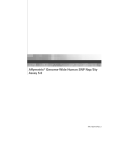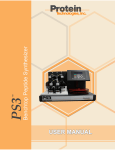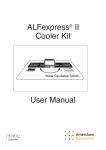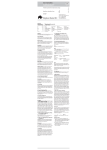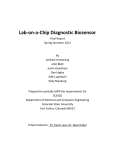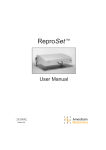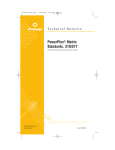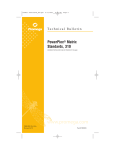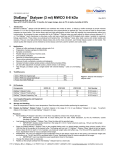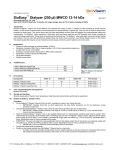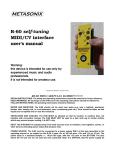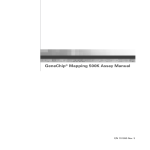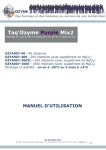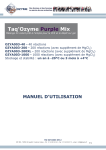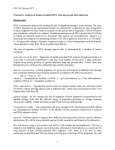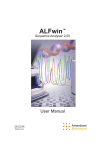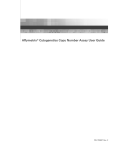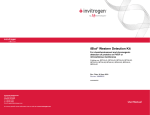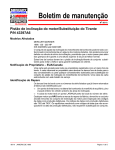Download Long Ranger™ 50% Gel Solutions - Protocol
Transcript
Lonza Rockland, Inc. www.lonza.com [email protected] Scientific Support: 800-521-0390 Customer Service: 800-638-8174 Document # 18693-0311-06 Rockland, ME 04841 USA Long Ranger™ 50% Gel Solutions ™ AccuGENE TBE Buffers Complete Solutions for DNA Sequencing and Genotyping Let Lonza partner with you to meet your sequencing and STR analysis research goals. We are committed to offering you a family of products and services designed to increase your throughput, efficiency and quality. We continue to work with many world class genome facilities and core laboratories offering them the best products for their specific research needs through our varied product line, technical support and application development. Allow us to contribute to your research success. Specifications Components: Filtered: Conductivity: pH: Storage: Long Ranger™ Gel Solution - Long Ranger™ Gel Solution is the core of our sequencing and genotyping product line. Due to its patented gel formulation, Long Ranger™ Gels produce longer, accurate reads. Preparing Diluted Solutions Dilute the liquid concentrates with deionized water. Do not store diluted solutions for longer than 24 hours. Buffer Preparation Precautions Handling and use of Long Ranger™ Gel Solution are identical to handling conventional acrylamide solutions. Wear gloves and use all safety precautions required for handling acrylamide solutions. Please read the material safety data sheets (MSDS) prior to use. 10X TBE Concentration 0.89 M Tris Base 0.89 M Boric Acid 0.02 M Na2EDTA•2H20 Long Ranger AccuGENE Buffers ™ 50% Gel Solution 5X and 10X TBE grams/L 108.0 g 55.0 g 7.44 g Add deionized water to a final volume of 1L, mix thoroughly and filter through ≤0.45 µm membrane. Storage Conditions Avoid storing solutions in direct sunlight. ™ 10X 0.89 M Tris Base 0.89 M Boric Acid 0.02 M Na2EDTA•2H2O 18 MΩ water 2 µm 3.8-5.06 mS/cm 8.0-8.5 18°C-24°C Storage Conditions TBE buffers should be stored at room temperature and out of direct sunlight. TBE buffers are stable for up to 3 months from date of manufacture. AccuGENE™ TBE Buffer - Our buffer is prepared from the same qualified reagents used to produce our gel solutions. Liquid concentrates are quality tested to ensure lot-to-lot consistency. Storage Temperature Room temperature Room temperature 5X 0.445 M Tris Base 0.445 M Boric Acid 0.01 M 2 2 Na EDTA• H2O 18 MΩ water 2 µm 3.14-3.50 mS/cm 8.25-8.38 18°C-24°C Shelf Life NOTE: To obtain optimal results and prevent precipitation of TBE stock solution, do not allow any dust particles to enter the container and pour from the bottle rather than inserting a pipette. Make in ≤1 L amounts. Do not store in carboy. Store at room temperature. Do not use if precipitate forms. 24 months 3 months AccuGENE™ 5X and 10X TBE Buffers Liquid Concentrate for Automated DNA Sequencing Prepared from qualified reagents, which are used in Long Ranger™, AccuGENE™ 5X and 10X TBE liquid concentrates, are quality tested to ensure lot-to-lot consistency. Supplied in a convenient container with a spigot. Long Ranger™ 50% Gel Solution for Automated DNA Sequencing Long Ranger™ 50% Gel Solution works with all automated sequencers and is compatible with both dye terminator and dye primer chemistry. Long Ranger™ Gels offer uniform spacing and sharp peaks, resulting in long, high-accuracy read lengths. We typically 1 observe a 25% to 30% increase in read length and an increase in base calling accuracy on automated sequencers when comparing the Long Ranger™ matrix with standard polyacrylamide gels. 6. Filter the solution through Whatman® #1 filter paper (11mM) or a Nalgene™ cellulose acetate filter (≤0.45 µm). 7. If desired, degas the solution for 5 minutes. 8. Add the appropriate amount of TEMED and APS. Mix gently. Storage Conditions Long Ranger™ 50% Gel Solution is stable for 24 months from the date of manufacture when stored at room temperature. Store solutions away from direct sunlight. Gel Casting The following steps must be completed without delay. 1. Cast gel and insert comb according to your standard procedure. 2. Once the gel is polymerized (approximately 30 minutes), place paper towels soaked in electrophoresis buffer over the ends of the plates and then cover with plastic wrap. This will prevent moisture loss as the polymerization process continues. 3. Allow 2 hours for complete gel polymerization. For Best Results • Do not prepare and store premix solutions made from Long Ranger™ 50% Gel Solution. • Ensure the glass plates are thoroughly clean and dust free. Glass plates can accumulate fluorescent contaminants from many sources including detergents, marker pens, ethanol and other solvents, poor quality water, and hands or gloves. These invisible contaminants can seriously affect data collection. • Once the gel is polymerized (approximately 30 minutes), place paper towels soaked in electrophoresis buffer over the ends of the plates and then cover with plastic wrap. This will prevent moisture loss as the polymerization process continues. Wrapped gels may be stored at 4°C overnight. • New instrument (matrix) files may need to be prepared for ABI machines when changing reagents or dye sets. Preparing for Electrophoresis 1. Remove the comb and wash the plates as described in the ABI Automated Sequencer Manual. 2. Prepare a sufficient quantity of electrophoresis buffer to fill both anodal and cathodal chambers by diluting 10X TBE stock with deionized water to 1X. 3. Mount the gel cassette onto the sequencing apparatus according to the manufacturer’s instructions. 4. To assure plates and gel are clean, perform the Plate Check module specific to the dye set you are using. Electrophoresis with the ABI Automated DNA Sequencers Gel Preparation 1. Assemble glass plates and spacers in the cassette following the method described in your automated sequencer instructions, or use the Owl Otter™ Sequencing Gel Caster (Model #SGC-1). 2. Mix the gel solution appropriate for your sequencer according to the formulations in the table below. 377-36 cm plates 377-48 cm plates 373-48 cm plates 373-34 cm plates Total Volume 5% LR/6 M Urea 1X TBE 50 ml 4.75% LR/6 M Urea 1X TBE 50 ml 5% LR/8.3 M Urea 1X TBE 100 ml 5.75% LR/7 M Urea 1X TBE 100 ml Urea 18.0 g 18.0 g 50.0 g 42.0 g dd Water Long ™ Ranger 50% 26 ml 26.25 ml 42 ml 46.5 ml 5 ml 4.75 ml 10 ml 11.5 ml 5 ml 5 ml 10 ml 10 ml 250 µl 250 µl 500 µl 500 µl 35 µl 35 µl 70 µl 70 µl Components 10X TBE Fresh 10% APS TEMED 3. Place the specified quantity of the first four components into a clean beaker and mix gently. 4. To facilitate dissolving the urea, the solution may be warmed, but cool the solution to room temperature prior to the addition of TEMED and APS. 5. If necessary, after the urea has dissolved, bring up to volume with deionized water. 2 ABI Prism® 377 with 36 and 48 cm Plates Electrophoresis with the LI-COR® Sequencing Systems Gel Preparation 1. Assemble glass plates and spacers in the cassette following the method described in the Li-COR® Automated Sequencer Manual. 2. Mix the gel solution appropriate for your gel concentration according to the formulation in the table below. NOTE: Prepare an analysis matrix standard file for Long Ranger™ Gel Solution as described in the ABI Prism 377 Automated Sequencer Manual. 1. Prepare sample sheet as normal using an appropriate setting. 2. Pre-run the gel using the desired module until a temperature of 51°C is achieved, about 10-20 minutes. Do not pre-run longer than necessary to reach 51°C. 3. Prepare DNA samples as you would for standard automated sequencing gels. 4. After pre-run is complete, pause the instrument and rinse the wells thoroughly with electrophoresis buffer. 5. Load samples as described in the ABI Automated Sequencer Manual. 6. Run the gel using the desired module. 7. Analyze data as usual. Gel Length 33 or 41 cm plates Spacer Thickness 0.25 mm Gel Composition 6% Long Ranger 7 M Urea/1.2X TBE 0.2 mm 5.5% Long ™ Ranger 7 M Urea/1X TBE 25.2 g 25.2 g 10X TBE 7.2 ml 7.2 ml 6.6 ml 6.0 ml dd Water (fill to) 60.0 ml 60.0 ml Urea ™ ® Long Ranger 50% Gel Solution ABI 373A with 48 cm Plates NOTE: Prepare an analysis matrix standard file for Long Ranger™ Gel Solution as described in the ABI 373A Automated Sequencer Manual. 1. Set the run parameters to 48-cm run length, full scan mode, 4.0% gel type, 31W power and 16-18h collection time. Set the parameters for the data collection software as usual. 2. Pre-run the gel for 10-20 minutes, then press “abort run” to stop the pre-run. Rinse the wells thoroughly with electrophoresis buffer. 3. Load samples as described in the ABI Automated Sequencer Manual. 4. Immediately after loading the last sample, press “resume run” and start data collection as usual. 5. Analyze data as usual. 3. Place a 100 ml beaker with a stir bar on a balance and tare the balance. 4. Measure 25.2 g of urea into the beaker. 5. Add the recommended amounts of acrylamide and 10X TBE to the beaker. 6. Add distilled-deionized water to a target weight of 67.5 grams (= 60 ml of gel solution). 7. To facilitate the dissolving of urea, the solution may be warmed. Prior to the addition of APS and TEMED, cool to room temperature. 8. Mix well and filter the solution through Whatman® #1 filter paper or a Nalgene® cellulose acetate filter (≤0.45 µm). 9. Add 400 µl of fresh 10% APS per 60 ml of gel solution and swirl gently. 10. Add 40 µl of TEMED per 60 ml of gel solution and swirl gently. ABI 373A with 34 cm Plates NOTE: Prepare an analysis matrix standard file for Long Ranger™ Gel Solution as described in the ABI 373A Automated Sequencer Manual. 1. Set the run parameters to 34-cm run length, full scan mode, 4.75% gel type, 30W power and 16h collection time. Set the parameters for the data collection software as usual. 2. Pre-run the gel for 10-20 minutes, then press “abort run” to stop the pre-run. Rinse the wells thoroughly with electrophoresis buffer. 3. Load samples as described in the ABI Automated Sequencer Manual. 4. Immediately after loading the last sample, press “resume run” and start data collection as usual. 5. Analyze data as usual. Gel Casting The following steps must be completed without delay. 1. Cast gel and insert comb according to your standard procedure. 2. Once the gel is polymerized (approximately 30 minutes), place paper towels soaked in electrophoresis buffer over the ends of the plates and then cover with plastic wrap. This will prevent moisture loss as the polymerization process continues. 3. Allow 2 hours for complete gel polymerization. 3 Preparing for Electrophoresis 1. Remove the comb, and rinse the wells or top surface of the gel with electrophoresis buffer. 2. Mount the cassette into the sequencing apparatus according to the manufacturer’s instructions. 3. Prepare a sufficient quantity of running buffer to fill. anodal and cathodal chambers by diluting 10X TBE stock to 1X with distilled water Gel Casting The following steps must be completed without delay. 1. Cast gel and insert comb according to your standard procedure. 2. Once the gel is polymerized (approximately 30 minutes), place paper towels soaked in electrophoresis buffer over the ends of the plates and then cover with plastic wrap. This will prevent moisture loss as the polymerization process continues. 3. Allow 2 hours for complete gel polymerization. Electrophoresis Conditions Parameter 33 cm Standard Protocol 33-cm-STD.col 41 cm Standard Protocol 41-cm-STD.col Quik33cm.col Quik41cm.col 1500 volts 1500 volts Current 35.0 mA 35.0 mA Power 45.0 watts 31.5 watts Temperature 50°C 50°C Scan Speed * * Pre-run time 20-30 minutes 30 minutes Frames to Collect 25 25 Data Collection Config file Quick SequencIR Config file Voltage Preparing for Electrophoresis 1. Remove the comb and rinse the wells or top surface of the gel with electrophoresis buffer. 2. Mount the gel cassette onto the sequencing apparatus according to the manufacturer’s instructions. 3. Prepare a sufficient quantity of running buffer to fill both anodal and cathodal chambers by diluting 10X TBE stock to 0.5X. Electrophoresis Conditions ® ® ALFexpress ALF Parameter Value Value Voltage 1500 Volts 1500 Volts Electrophoresis with the Pharmacia ALF , ALFexpress® and ALFexpress® II DNA Sequencing System Current 60 mA 60 mA Power 25 Watts 25 Watts Temperature 55°C 45°C-50°C Gel Preparation Sampling Interval 2 seconds 2 seconds 1. Assemble glass plates and spacers in the cassette following the method described in the ALF®, ALFexpress® or ALFexpress® II Instruction manual. 2. Mix the gel solution according to the formulations in the table below and following the appropriate instruction manual. Gel Thickness 0.3 mm and 0.5 mm Run Time 900 minutes * For 0.25 mm thick gels, use a Scan Speed of 2 (=1.2 frames/hr). For 0.2 mm thick gels, use a Scan Speed of 3 (=2.4 frames/hr). ® ® ALF express & ® ALFexpress II ALF Fragment Analysis Using Long Ranger™ Gel Solution on ABI Automated Sequencers For Best Results ® • Consult your ABI GeneScan Manual for detailed information and procedures. • Do not prepare and store premix solutions made from 50% Long Ranger™ Gel Solution. • Ensure the glass plates are thoroughly clean and dust free. Glass plates can accumulate fluorescent contaminants from many sources including detergents, marker pens, ethanol and other solvents, poor quality water, and hands or gloves. These invisible contaminants can seriously affect data collection. • Once the gel is polymerized (approximately 30 minutes), place paper towels soaked in electrophoresis buffer over the ends of the plates and then cover with plastic wrap. This will prevent moisture loss as the polymerization process continues. Wrapped gels may be stored at 4°C overnight. • New instrument (matrix) files may need to be prepared for ABI machines when changing reagents or dye sets. ® Spacer Thickness 0.3 mm 0.5 mm Urea Long Ranger™ Gel Solution Gel buffer 6M 6M 7M 5% 5.5%-6% 5.5%-6% 1.5X 1.5X 1.2X Running buffer 0.5X 0.5X 0.6X 900 minutes 3. Prepare gel solutions in deionized water. 4. Follow our recommended 10X TBE buffer formulation. 5. To facilitate dissolving the urea, the solution may be warmed, but cool the solution to room temperature prior to the addition of TEMED and APS. 6. Filter the solution through Whatman® #1 filter paper or a Nalgene® cellulose acetate filter (≤0.45 µm). 7. If desired, degas the solution for 5 minutes. 8. Add 250 µl APS and 25 µl TEMED for every 50 ml of gel solution. Mix gently. 4 apparatus according to the manufacturer’s instructions. 4. To assure plates and gel are clean, perform the Plate Check specific for your dye set. Gel Preparation 1. Assemble glass plates and spacers in the cassette following the method described in your automated sequencer instructions, or use the Owl Otter™ Sequencing Gel Caster (Model #SGC-1). 2. Mix the gel solution appropriate for your sequencer according to the formulations in the table below. If using our Long Ranger™ PreMix Solutions, add the appropriate amounts of APS and TEMED to volume of PreMix required for your plate length and mix gently. Total Volume 377-36 cm plates 5% LR 6M Urea 1X TBE 50 ml 373-34 cm plates-full scan 5.75% LR 8.3M Urea 1X TBE 100 ml 373-34 cm-18 BaseSprinter 5.25% LR 8.3M Urea 1XTBE 100 ml Urea 18.0 g 55.0 g 50.0 g Components 26 ml 46.5 ml 41.5 ml Long Ranger 50% 10X TBE 5.0 ml 11.5 ml 10.5 ml 5 ml 10 ml 10 ml Fresh 10% APS 250 µl 500 µl 500 µl TEMED 35 µl 70 µl 70 µl dd Water Electrophoresis ABI Prism® 377 with 36 cm Plates 1. Pre-run gel using the desired module until a temperature of 51°C is achieved, about 10-20 minutes. Do not pre-run longer than necessary to reach 51°C. 2. Prepare samples following your standard procedure. 3. After pre-run is complete, pause the instrument and rinse the wells thoroughly with electrophoresis buffer. 4. Load samples as described in the ABI GeneScan® Analysis Software User’s Manual. 5. Run the gel using the desired run module. Run time will be 2 hours. In some cases, a 2.5 hour run time may be necessary to see all your fragments. 6. Analyze data as usual ™ ABI 373A with 34 cm Plates 1. Set the run parameters to 34-cm run length, full scan mode, 4.75% gel type, 30W power and 16h collection time. Set the parameters for the data collection software as usual. 2. Pre-run the gel for 10-20 minutes, then press “abort run” to stop the pre-run. Rinse the wells thoroughly with electrophoresis buffer. 3. Load samples as described in the ABI GeneScan® Analysis Software User’s Manual. 4. Immediately after loading the last sample, press “resume run” and start data collection as usual. 5. Run the gel using the desired run module. Run time will be 2 hours. In some cases, a 2.5 hour run time may be necessary to see all your fragments. 6. Analyze data as usual. 3. Place the specified quantity of the first four components into a clean beaker and mix gently. 4. To facilitate dissolving the urea, the solution may be warmed, but cool the solution to room temperature prior to the addition of TEMED and APS. 5. If necessary, after the urea has dissolved, bring up to volume with deionized water. 6. Filter the solution through Whatman® #1 filter paper or a Nalgene® cellulose acetate filter (≤0.45 µm). 7. If desired, degas the solution for 5 minutes. 8. Add appropriate amounts of APS and TEMED. Mix gently. Tips and Troubleshooting for Automated Sequencing Gel Casting Please consult your instrument instruction manual for tips concerning machine operation. The following steps must be completed without delay. 1. Cast gel and insert comb according to your standard procedure. 2. Once the gel is polymerized (approximately 30 minutes), place paper towels soaked in electrophoresis buffer over the ends of the plates and then cover with plastic wrap. This will prevent moisture loss as the polymerization process continues. 3. Allow 2 hours for complete gel polymerization. Polymerization The rate of polymerization and properties of the gel depend on the quality and concentration of reagents used and attention to detail. Slow polymerization will cause gels to be more porous and weak. Fast polymerization will result in an increase in gel turbidity and decrease in gel elasticity. It is important to note that polymerization continues long after visible gelation occurs. Gelation should occur within 15-20 minutes and complete polymerization will occur in 2 hours. Polymerization can be slowed or inhibited by oxygen and contaminants in buffers and urea. • We recommend allowing gels to polymerize for 2 hours prior to use. • Use only high quality reagents. Preparing for Electrophoresis 1. Remove the comb and wash the plates as described in the ABI Automated Sequencer Manual. 2. Prepare a sufficient quantity of electrophoresis buffer to fill both anodal and cathodal chambers by diluting 10X TBE stock with deionized water to 1X. 3. Mount the gel cassette onto the sequencing 5 Ammonium Persulfate (APS) and TEMED • Use the recommended amounts of APS and TEMED. • APS begins to break down and loses activity almost immediately when exposed to water. APS should consist of free flowing crystals. We recommend preparing fresh 10% APS solutions daily. • TEMED loses its catalytic activity when it has been oxidized. TEMED containing oxidation products is yellow and starts to lose its foul odor, and should be discarded. Use TEMED within the manufacturer’s recommended expiration date. • • Temperature Temperature has a direct effect on the rate of polymerization and properties of the gel. If the temperature is too high, polymerization will occur very rapidly and gels will be elastic. If the temperature is too low, polymerization will be slow and gels will be very porous. • Allow the Gel Solution to come to room temperature prior to the addition of APS and TEMED. • The optimal temperature for gel polymerization is 23°C-25°C. • To ensure gel-to-gel consistency, pour gels at the same temperature. • Allow the Gel Solution to come to room temperature prior to degassing. • • Glass Plates Use of perfectly clean apparatus and glassware is critical. In high throughput labs where each set of plates is used many times per week, frequent inspection of the plates is particularly important. The care applied to these tasks will be highly rewarded. Several aspects of fluorescent sequencing may be affected by the condition of the glass plates. Glass plates may accumulate fluorescent contaminants from detergents, marker pens, ethanol or other solvents, poor quality water, greasy hands or gloves etc. This is not visible to the eye but may seriously affect data collection. • Glass with chipped edges may not fit correctly on the aligning pins in the ABI Prism® 377 Automated Instrument, or may cause problems at casting. • Do not let used plates dry out before cleaning them. Dried gel is hard to remove, but very easy when still moist. Separate the plates and remove the gel by lifting with paper towels. ® • Use 0.5%-2% Alconox detergent and warm water. If ® Alconox is not obtainable in your region, consult your local ABI Technical Staff for a recommended alternative. Other cleaning agents may leave fluorescent deposits. Wear clean, rinsed, powder-free gloves and avoid scratching and scraping the plates. If tap water is used with Alconox®, rinse the plates thoroughly after soaping with distilled or deionized water. • Stand clean plates in an A-shaped Plate Drying Rack (Lonza Catalog No. 50641) to air dry, protected from splashes and dust (e.g. do not place it right next to the sink). They should look spotless when dry. Canned air such as Dust-Off® is useful for removing minor dust particles just before casting. Good dishwashing machines work well for some labs, but it is important not to let any gel dry onto the plates before running the machine. Check the washed plates carefully before use, and reject any plates with adhering particles or smears. Condition of combs and spacers is important: Do not use damaged combs or spacers, since gel thickness or well formation may be affected. Variations in gel thickness and imperfections in the gel surface of the wells may cause band distortions that impair resolution. Note that the comb may be warped; the thin, flexible part may then form a slightly concave upper surface at the top of the gel. If this happens it is very difficult to insert the sharkstooth evenly because the teeth at the sides must be pushed well into the gel before the central teeth even touch the gel surface. This causes deformation of the wells at the sides. The tips of the sharkstooth on a warped comb form a slightly convex line, making the problem worse. Some labs find it useful to treat their glass plates with 2 M NaOH or 2 M HCl at regular intervals to remove traces of fluorescent contaminants. Overnight soaking is not recommended. One or two hours in NaOH, followed by thorough rinsing with deionized water is effective. Be sure to use appropriate caution when handling the strong alkali or acid. Storage of the Gel • Polymerized gels may be stored up to 24 hours. To protect them from drying, after polymerization, cover the ends with paper towels dampened with 1X TBE buffer, and wrap with plastic wrap. In warm weather, storage overnight at 4°C is suggested. Swelling of the Gel • Some labs occasionally observe the gel swelling dramatically out of the top of the plates during electrophoresis. The swelling is caused by electroendosmosis, due to electrostatic charge on the glass surface. In this situation, cleaning with 2 M HCl is effective. Electrophoresis Buffer • TBE solutions should be free of precipitate. If a precipitate has formed, discard the buffer and prepare new buffer. • Filter stock solutions through a 0.45 µm filter and store in glass containers. Tris-TAPS EDTA (TTE) electrophoresis buffer can be used with Long Ranger™ Gel Solution on your ABI Prism® 377 DNA Sequencer to achieve longer read lengths. Prepare a 4.25% Long Ranger™ Gel, 6 M urea and 1.2X TTE. Instrument (matrix) File-ABI Automated DNA Sequencers • When you change from one matrix to a different matrix, we recommend that you make a new instrument file (matrix file) on your first gel run. You need to make a separate file for each instrument, as 6 • • the file is only valid for the instrument on which it was made. Load appropriate matrix standards and follow the easy instructions in your ABI Users Manual. Remember, do not run the base caller on the matrix standard lanes; the new file is made from the raw data. Mobility files cannot be changed by the user. The files supplied with the sequencer should be used, unless at some point in the future the instrument manufacturer creates new files for Long Ranger™ Gels. • • • Soak plates for 20 minutes in 2 M NaOH. Clean glass plates immediately after the electrophoresis run. Clean plates as suggested in previous Tip for Glass Plates. Long Ranger™ 50% Gel Solution for Manual Sequencing Long Ranger™ 50% Gel Solution is a chemically unique, patented gel formulation containing a novel cross-linker. Long Ranger™ Gels can be used to sequence both DNA and RNA. Long Ranger™ Gels allow a short length of sequence to be read in half the time when compared with the same concentration conventional polyacrylamide gels. Long Ranger™ Gels also handle better than polyacrylamide gels; they are stronger and more elastic. Red Rain Red rain is caused by air bubbles occurring in areas where the gel is under heat stress. There are two places in the gel where bubbles can occur: the read area where the laser impact creates heat, and around the edge of the upper buffer tray above the front heat plate. Localized heat in both of these areas cannot be dissipated away by the front heat plate. Manipulations that introduce excessive air while casting will result in gels that are more prone to Red Rain. Long runs at high temperature or fast laser scan speeds can increase the chances of Red Rain appearing towards the end of the run due to prolonged heat stress. If modules are altered, the speed of the run and the quality of resolution may be changed. Increased voltage or temperature may increase the probability of Red Rain. Red Rain may also be caused by foreign particles in the gel. • TBE solutions should be free of precipitate and filtered through 0.45 µm filters. • Avoid any action that mixes the gel solutions with air. Slowly and gently mix solutions by hand or on a stir plate. • Cast gels in a way that avoids the introduction of too much air into the gel. • Clean plates as suggested in previous Tip for Glass Plates. Storage Conditions Long Ranger™ 50% Gel Solution is stable for 24 months from the date of manufacture when stored at room temperature. Store away from direct sunlight. For Best Results • Solutions of TBE containing visible precipitate should not be used. Borate can precipitate out of concentrated solutions of TBE. This will change the buffering capacity, ionic strength and the pH of the solution. • Allow the gel solution to come to room temperature before adding APS and TEMED. • Do not use electrophoretic conditions that cause the gel to become warmer than 50°C. • Treat only one glass plate with silanizing solution. Over silanization can cause bubbles during gel casting, gel swelling during electrophoresis and gel detachment from the glass plate. • To minimize gel swelling during fixing, a 20% ethanol and 10% acetic acid fixing solution should be used. Gel Preparation and Pouring 1. Glass plates must be clean and free of dried gel and soap residues. To remove residues, apply ethanol to both plates and wipe dry. 2. Ensure that the gel will not stick to the glass plates by silanizing only one plate. 3. Assemble glass plates according to manufacturer’s instructions. 4. For maximum readable bases (multiple loads), we recommend a 5% or 6% gel in 1X TBE gel and running buffers. For fast runs of 200 to 300 bases, prepare a 5% or 6% gel with 0.6X TBE in both gel and running buffers. If the sequence you intend to read is closer to the primer, pour an 8% Long Ranger® Gel with 0.6X TBE in both gel and running buffers. 5. Place the specified quantity of the first three components from the table below into a clean beaker or 50 ml centrifuge tube and mix gently by swirling or inversion. Gel Dropout Gel dropout is a fading signal around 140 bp-220 bp. The plates seem to have a long polymer bound which is released when the gel heats up during the run. Once released the polymer binds to the OH group of the migrating DNA and quenches the signal. • The use of glassware dishwashers eliminates gel dropout. The combination of extremely high water temperature and prolonged physical agitation in a dishwasher effectively removes any residue buildup. • Clean glass plates immediately after the electrophoresis run. 1 • Detergents and chemical washes can also be used. Green or Blue Haze Green haze in the back of the gel is common. It can be seen on the image window of the ABI 377. It is not usually strong enough to interfere with the other bands. It is caused by a build up of fluorescent materials on the plates or misaligned plates. 7 ™ Preparation of Long Ranger Gels (50 ml Total Volume) Components 5% 6% 8% 21.0 21.0 21.0 Urea (7M) g g g 10X TBE 5 ml 5 ml 5 ml ™ 5 ml 6 ml 8 ml 50% Long Ranger Solution Distilled-deionized Water (fill 50 50 ml 50 ml to) ml TEMED 25 µl 25 µl 25 µl 250 250 250 10% APS µl µl µl NOTE: This recipe should be proportionately adjusted based on the amount of gel needed to fill your plates. when the bromophenol blue is approximately 3 cm from the bottom of the gel (see tables below). ™ Approximate Running Times of Long Ranger Gels >600 Bases Read 250 400-500 (double load) 10-15 Pre-run 10-15 minutes 10-15 minutes minutes Run Time 2 hours 4 hours 6-8 hours ™ Dye Migration in Long Ranger Gels (1X TBE) 6. To facilitate dissolving the urea, the solution may be warmed, but cool the solution to room temperature prior to the addition of TEMED and APS. 7. After the urea has dissolved, bring up to volume with deionized water. 8. If desired, and after the urea has dissolved, filter the solution through Whatman® #1 filter paper or a Nalgene® cellulose acetate filter (≤0.45 µm). 9. If desired, degas the solution for 5 minutes. 10. Add the specified amounts of TEMED and 10% APS and mix the solution by inversion or gentle swirling. 11. Pour the gel solution into the plates using the standard procedure for acrylamide. 12. Insert comb (in an inverted position if using a sharkstooth comb), and allow to polymerize for at least 30 minutes at room temperature. 13. Remove the comb, and rinse the wells or top surface of the gel with electrophoresis buffer. 14. Mount the gel cassette onto the sequencing apparatus according to the manufacturer’s instructions. 15. Prepare a sufficient quantity of running buffer to fill both anodal and cathodal chambers by diluting 10X TBE stock to 1X with deionized water. Gel % Bromophenol Blue Xylene Cyanol 5 40 bp 175 bp 6 20 bp 138 bp 7 19 bp 123 bp 8 11 bp 98 bp Autoradiography 1. When the run is complete, turn off the power supply, disconnect electrodes and remove the plates from the apparatus. 2. Long Ranger™ Gels do not require fixing or removal 35 of urea for P labeled reactions. If your application requires fixing, soak in 20% ethanol and 10% acetic acid for 10 to 20 minutes. 3. Allow the plates to cool briefly before separating. Transfer the gel onto Whatman® filter paper. 4. Place the Whatman® paper on a flat surface with gel side up and cover with plastic wrap. 32 5. Dry the gel (not required for P-labeled gels) under vacuum at 70°C-80°C for 30 to 60 minutes. Remove the plastic wrap and expose gel to X-ray film using standard techniques. Formamide in Long Ranger™ Gels Unreadable or errors in interpretation on a sequencing film are often caused by the phenomenon of compressions. A compression is usually associated with intermolecular base pairing in a primer extension which is G-C rich. The folded structure or hairpin loop persists during the electrophoresis and runs faster through the gel matrix than the equivalent unfolded structure. The resulting autoradiogram of such a DNA sequence is diagnosed by bands running very close together, usually with a gap or increased band spacing in the region above. One method of eliminating gel compressions is to increase the denaturing conditions in the gel matrix by adding formamide (in addition to urea). Electrophoresis 1. Pre-run the gel for 10 to 15 minutes before loading the samples. Use 28 - 35 Watts for 35 ml gels (40 cm x 20 cm x 0.4 mm) or 55 - 66 Watts for 70 ml gels (40 cm x 40 cm x 0.4 mm). 2. Prepare DNA samples as you would for standard sequencing gels: denature samples for 2 to 5 minutes at 75°C or the temperature recommended for the enzyme you are using, and immediately chill on ice. 3. After the pre-run, rinse the well(s) thoroughly with electrophoresis buffer. Reinsert the sharkstooth comb so it just touches the gel, and load samples. 4. Adjust the power so that the temperature of the glass plates is between 40°C-50°C. We recommend using 28 - 35 Watts for 35 ml gels and 55 - 66 Watts for 70 ml gels. Monitor the temperature of the plates and adjust wattage to maintain the desired temperature. 5. Monitor the run time with the marker dyes bromophenol blue and xylene cyanol (often contained in sequencing kit stop solutions). When doing multiple loads, the second loading should be added Prepare and assemble glass plates as described above. As with a standard polyacrylamide gel, it is necessary to increase the Long Ranger™ Gel Solution concentration to 8% when formamide is added. For making 50 ml of 8% Long Ranger™ Gel containing 40% formamide, follow the table below. Adjust the quantity of each component proportionately for preparing greater than 50 ml of gel solution. 8 1. Place the specified quantity of the first four components from the table below into a clean beaker or 50 ml centrifuge tube and mix gently by swirling or inversion. Once urea has dissolved, bring final volume to 50 ml with deionized water. Component References 1. Applied Biosystems. (2001). Cleaning Glass Plates to Eliminate Temporary loss of signal. P/N 4306162. 2. [User Bulletin] Applied Biosystems. (2001). Achieving Longer High-Accuracy Reads on the 377 Sequencer. P/N 4315153 3. Shorr, Robert. (1993). Electrophoretic Media. U.S. Patent 5219923. 4. Cambrex Inc. (1998). Long Ranger™ Singel™ Packs for Automated Sequencing. [ReSource Note] # 01298. Amount ™ 50% Long Ranger Solution 8 ml Formamide 20 ml Urea 21.0 g 10X TBE 5 ml Distilled-deionized Water Fill to 50 ml TEMED 60 µl Fresh 10% APS 400 µl 2. To facilitate dissolving the urea, the solution may be warmed, but cool the solution to room temperature prior to the addition of TEMED and APS. 3. After the urea has dissolved, bring up to volume with deionized water. 4. If desired, and after urea has dissolved, filter the solution through Whatman® #1 filter paper or Nalgene® cellulose acetate filter (≤0.45 µm). 5. If desired, degas the solution for 5 minutes. 6. Add the specified amounts of TEMED and 10% APS and mix the solution by inversion or gently swirling. 7. Pour the gel solution into the plates and allow to polymerize for at least 30 minutes at room temperature. 8. Once polymerized, transfer plates to electrophoresis apparatus and prepare samples as described above. 9. Long Ranger™ Gels with formamide should be run at the same power settings as a regular Long Ranger™ Gel in 1X TBE. The running time should be increased to 4 to 5 hours since the addition of formamide slows the DNA migration about 50%. 10. When the run is complete, turn off the power supply, disconnect electrodes and remove the plates from the apparatus. 11. Allow the plates to cool briefly before separating. 12. A formamide gel must be fixed prior to drying. To minimize swelling, a 20% ethanol and 10% acetic acid fixing solution must be used. Place the glass plate with the gel still adhered in the fixing solution for 15 minutes. Leaving the gel on the plate inhibits the gel from swelling during fixing. 13. Remove the plate from the fixing solution and drain off excess fixing solution. 14. Transfer the gel to Whatman® 3MM paper. Cover with plastic wrap prior to drying. 15. Dry the gel under vacuum at 70°C-80°C for 30 to 60 minutes. 16. Remove the plastic wrap and expose to X-ray film using standard techniques. For Research Use Only. Not for Use in Diagnostic Procedures. ABI Prism, BigDye and GeneScan are trademarks of PE Corporation, Applied Biosystems Division. LI-COR is a trademark of LI-COR, Inc. ALF and ALFexpress are trademarks of Amersham Pharmacia Biotech AB. Nalgene is a trademark of Nalge Nunc International. Whatman is a trademark of Whatman Paper, Ltd. Otter is a trademark of Owl Separation Systems. Dust-Off is a trade-mark of Falcon Safety Products, Inc. Alconox is a trademark of Alconox, Inc. All other trademarks herein are marks of the Lonza Group or its affiliates. © 2011 Lonza Rockland, Inc. All rights Reserved. 9









